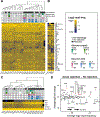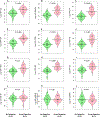Serum MicroRNA Transcriptomics and Acute Rejection or Recurrent Hepatitis C Virus in Human Liver Allograft Recipients: A Pilot Study
- PMID: 33979314
- PMCID: PMC8581074
- DOI: 10.1097/TP.0000000000003815
Serum MicroRNA Transcriptomics and Acute Rejection or Recurrent Hepatitis C Virus in Human Liver Allograft Recipients: A Pilot Study
Abstract
Background: Acute rejection (AR) and recurrent hepatitis C virus (R-HCV) are significant complications in liver allograft recipients. Noninvasive diagnosis of intragraft pathologies may improve their management.
Methods: We performed small RNA sequencing and microRNA (miRNA) microarray profiling of RNA from sera matched to liver allograft biopsies from patients with nonimmune, nonviral (NINV) native liver disease. Absolute levels of informative miRNAs in 91 sera matched to 91 liver allograft biopsies were quantified using customized real-time quantitative PCR (RT-qPCR) assays: 30 biopsy-matched sera from 26 unique NINV patients and 61 biopsy-matched sera from 41 unique R-HCV patients. The association between biopsy diagnosis and miRNA abundance was analyzed by logistic regression and calculating the area under the receiver operating characteristic curve.
Results: Nine miRNAs-miR-22, miR-34a, miR-122, miR-148a, miR-192, miR-193b, miR-194, miR-210, and miR-885-5p-were identified by both sRNA-seq and TLDA to be associated with NINV-AR. Logistic regression analysis of absolute levels of miRNAs and goodness-of-fit of predictors identified a linear combination of miR-34a + miR-210 (P < 0.0001) as the best statistical model and miR-122 + miR-210 (P < 0.0001) as the best model that included miR-122. A different linear combination of miR-34a + miR-210 (P < 0.0001) was the best model for discriminating NINV-AR from R-HCV with intragraft inflammation, and miR-34a + miR-122 (P < 0.0001) was the best model for discriminating NINV-AR from R-HCV with intragraft fibrosis.
Conclusions: Circulating levels of miRNAs, quantified using customized RT-qPCR assays, may offer a rapid and noninvasive means of diagnosing AR in human liver allografts and for discriminating AR from intragraft inflammation or fibrosis due to R-HCV.
Trial registration: ClinicalTrials.gov NCT00135694.
Copyright © 2021 Wolters Kluwer Health, Inc. All rights reserved.
Conflict of interest statement
T.T. is a cofounder of and scientific advisor to Alnylam Pharmaceuticals and a scientific advisor to Regulus Therapeutics. M.S. has a Consultancy Agreement with CareDx, Inc. Brisbane, CA and with Sparks Therapeutics, Philadelphia, PA. The other authors of this article declare no conflicts of interest. The other authors declare no conflict of interests.
Figures





Comment in
-
Circulating MicroRNAs: Dynamic Markers of Liver Transplant Injury.Transplantation. 2022 Apr 1;106(4):705-706. doi: 10.1097/TP.0000000000003816. Transplantation. 2022. PMID: 33979317 Free PMC article. No abstract available.
References
-
- Kwong A, Kim WR, Lake JR, et al. OPTN/SRTR 2018 annual data report: liver. Am J Transplant. 2020;20 Suppl s1:193–299. - PubMed
-
- Adams DH, Sanchez-Fueyo A, Samuel D. From immunosuppression to tolerance. J Hepatol. 2015;62(Suppl 1):S170–S185. - PubMed
-
- Cillo U, Bechstein WO, Berlakovich G, et al. Identifying risk profiles in liver transplant candidates and implications for induction immunosuppression. Transplant Rev (Orlando). 2018;32(3):142–150. - PubMed
-
- Levitsky J. Operational tolerance: past lessons and future prospects. Liver Transpl. 2011;17(3):222–232. - PubMed
-
- Demetris AJ, Bellamy C, Hübscher SG, et al. 2016 comprehensive update of the Banff Working Group on liver allograft pathology: introduction of antibody-mediated rejection. Am J Transplant. 2016;16(10):2816–2835. - PubMed
Publication types
MeSH terms
Substances
Associated data
Grants and funding
LinkOut - more resources
Full Text Sources
Other Literature Sources
Medical
Research Materials

